A private group tour today down in the Norfolk Broads. It was to be a day spent looking for birds, butterflies and dragonflies plus the odd orchid or two, a nice mixture of general wildlife. The day started cloudy but brightened up nicely and was bright and sunny with blue skies in the afternoon, even if the wind did pick up during the day again.
Our first destination was Potter Heigham. We were particularly hoping to see the Black-winged Stilts which have nested here, but it is possible to see a very good variety of different species here at the moment. As we made our way down along the access road, two Spoonbills were on one of the pools, the first of quite a few we would see here.
As we climbed up onto the bank, we could hear a couple of Reed Warblers singing. We eventually got a good look at one through the scope, perched up in the reeds. Along the river bank, there were a couple of Sedge Warblers singing too, which gave us a great opportunity to listen to the differences between them. One Sedge Warbler showed very nicely in front of us, so we could see its striking off white supercilium, very different from the plain face of the Reed Warbler. A Cetti’s Warbler shouted at us from deep in the bushes but typically didn’t show itself.
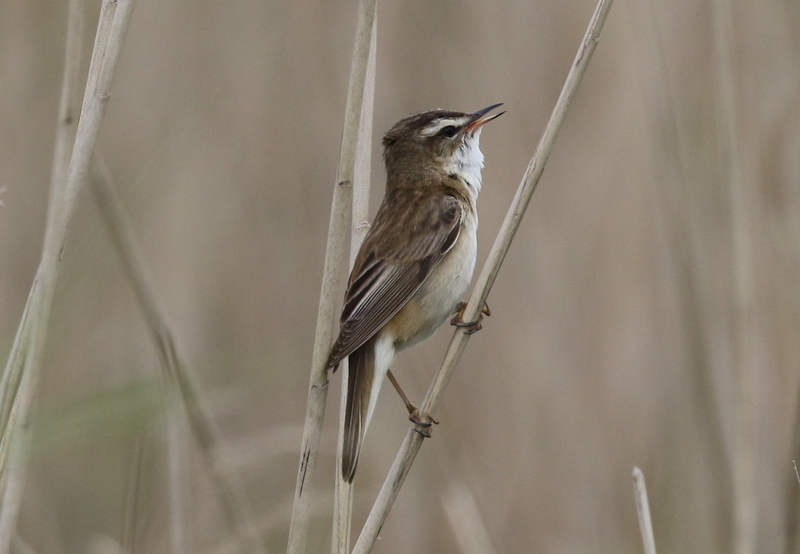 Sedge Warbler – singing from the reeds just ahead of us
Sedge Warbler – singing from the reeds just ahead of us
Walking round the reeds, we could hear Bearded Tits calling. It seemed unlikely we would see one perched up today, with a fresh breeze blowing, but we had a good look each time called nonetheless. Then two tawny brown long-tailed shapes flicked up into the top of the reeds and stayed there just long enough for us all to get a quick look at them. A pair of Bearded Tits. The male was closest to us and slightly higher up the reeds, so we could see its powder blue head and black moustache.
There were a few hairy Garden Tiger moth caterpillars on the path again this morning – we had to keep one eye on the ground to avoid standing on them. A little later, we saw a Jackdaw on a post trying to eat one. It clearly did not want to eat the hairs, so was trying to pull it apart but appeared to be struggling.
We walked quickly round to where the Black-winged Stilts have been and immediately located one standing in the shallow water on the edge of one of the islands. We got it in the scope and had a look at it. However, it was immediately clear this was not one of the pair, but instead a lone male which has been hanging around the site too, with a black (rather than brown-tinged) mantle but lacking the black on the head of the breeding male. Still, it was a smart bird and a great start.
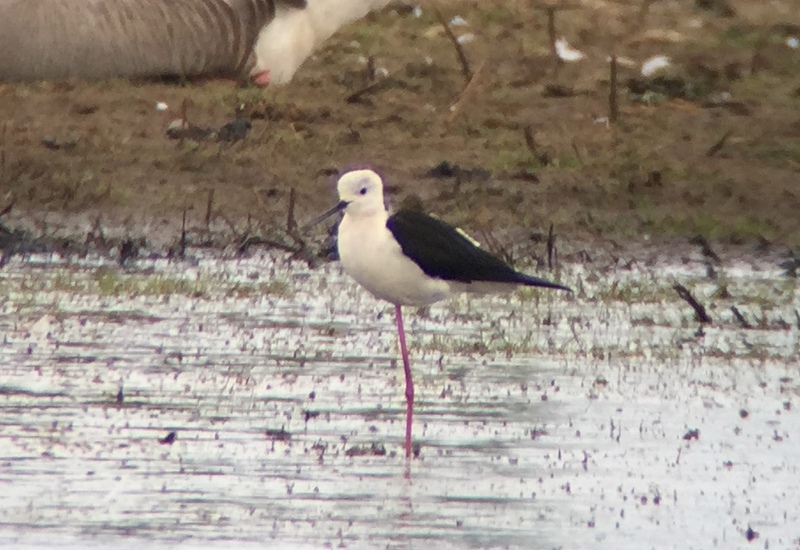 Black-winged Stilt – we found the lone male first this morning
Black-winged Stilt – we found the lone male first this morning
Just a short walk further along, we found the pair of Black-winged Stilts on a muddy island. At first, the female was looking after the chicks and the male was feeding nearby, before they switched roles and the male took over parenting duties. Black-winged Stilts are not particularly attentive parents, and the tiny juveniles, less than 3 days old were left to wander round the island and feed for themselves. They were quite hard to see in the cut reed stems but looking carefully through the scope, we got a good look at them.
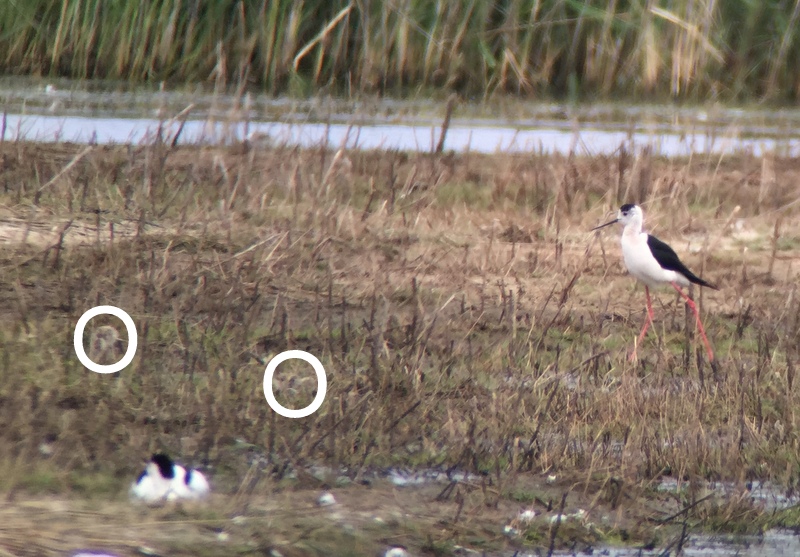 Black-winged Stilts – the male standing guard, with 2 of the 4 juvs nearby (circled)
Black-winged Stilts – the male standing guard, with 2 of the 4 juvs nearby (circled)
The adult Black-winged Stilts would fly up occasionally if a potential predator was detected coming overhead, a Marsh Harrier or a Lesser Black-backed Gull for instance. The Marsh Harriers made several passes over the pools and at one point a female surprised a couple of Coots in the water as it came low over a line of reeds. It looked like it was going to dive after one and hovered over the water for a second, but the Coots saw it at the last minute and managed to escape.
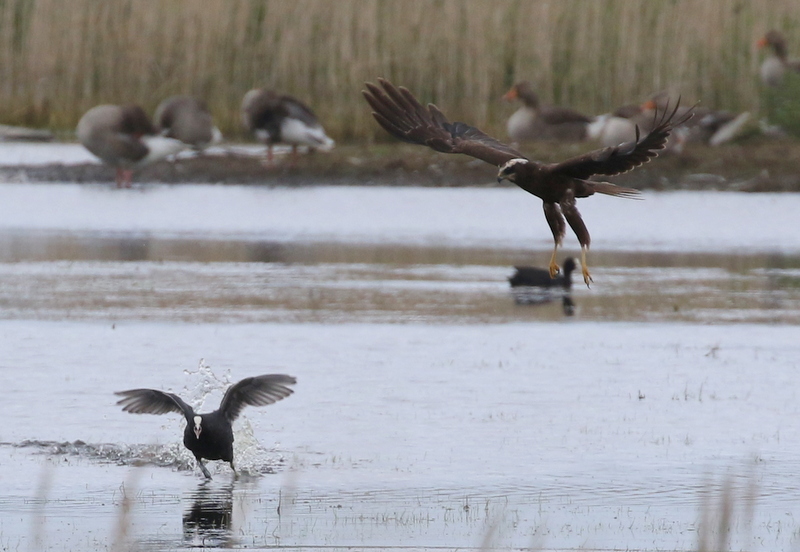 Marsh Harrier – thinking about attacking a Coot
Marsh Harrier – thinking about attacking a Coot
While we were busy watching the Black-winged Stilts, a shout from a small group of birders further along the path alerted us to a bird flying across in the distance. We thought it was going to be a Bittern at first, but looked up to see it was a Night Heron. There has been a young (1st summer) Night Heron here for the past couple of days, but it had only been seen at dusk as it emerges from the trees where it roosts during the day. It was therefore a nice surprise to see it during the day. We watched as it dropped away from us over the trees.
On the next pool along, we found three Spoonbills. They were doing what Spoonbills like to do best – sleeping! Occasionally, one would wake up long enough to flash its spoon shaped bill. We stood here for a while, and gradually more Spoonbills flew in from the direction of Hickling Broad, in small groups, and landed with them. Eventually we got up to twelve Spoonbills all together, but later as we walked back to the car, another one flew in so there were possibly 13 today in total.
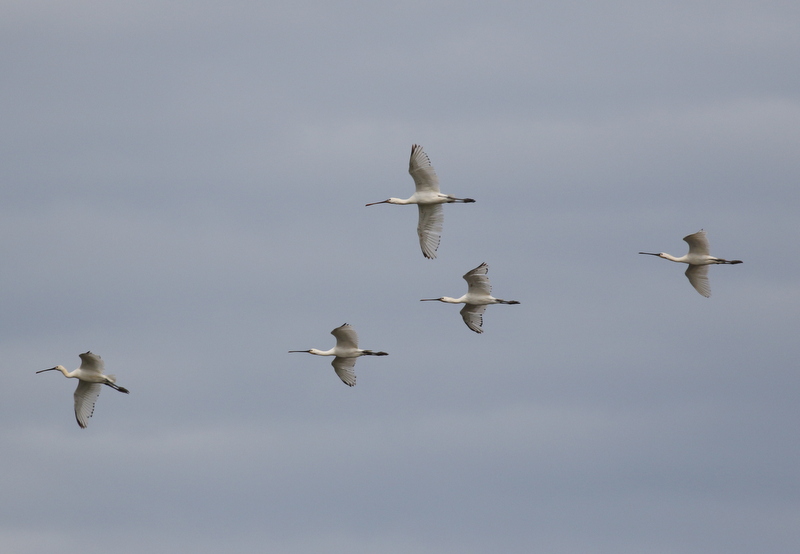 Spoonbills – another five flying in to the pools at Potter Heigham
Spoonbills – another five flying in to the pools at Potter Heigham
All the Spoonbills all appeared to be immature birds, some in their first summer with still extensively fleshy-coloured bills, but others older with yellow-tipped black bills. However, all lacked the full crest of a summer adult and the yellow-brown wash on the breast, or had black in the tips of their wings, which indicated they were still not mature. There were lots of Little Egrets here too, plus a couple of Grey Herons.
Black-winged Stilts and Night Herons are both more southerly European species which have overshot on their way north in the spring. Together with all the Spoonbills and Little Egrets, it gave a real Mediterranean feel to the birding at Potter Heigham this morning. All of which is presumably an indication of our changing climate.
There were not many other waders here this morning, apart from the breeding birds. A lone Ruff was the only wader which doesn’t breed here. As well as the Black-winged Stilts, there were plenty of breeding Avocets, plus Lapwings and a few Redshanks. A few Common Terns were nesting too and flying in and out. We also saw both Great Crested Grebe and Little Grebe on the pools here.
We had been hoping to see one the Garganey which have been lingering here this summer but all our scanning failed to locate one on our way round. There were plenty of other ducks – a single Wigeon, a few Teal and Shoveler, lots of Gadwall and a few Tufted Ducks. A female Common Pochard had a couple of ducklings following her. There were plenty of geese too – Greylags, Canada Geese and a couple of Egyptian Geese. As we turned to walk back, we spotted a drake Garganey flying in and it landed on the island with the Spoonbills. We got a nice look at it through the scopes before it went to sleep.
 Garganey – flew in and landed between the Spoonbills
Garganey – flew in and landed between the Spoonbills
The Norfolk Hawker is one of the rarer UK dragonflies, largely restricted in its distribution to the Norfolk Broads and neighbouring parts of Suffolk. So it was great to see one flying up and down the river bank here. It landed briefly, but tucked itself down in the vegetation out of the wind. In the end, we would see quite a few of them today, but this was the only one which stopped long enough for us to get a close look at it.
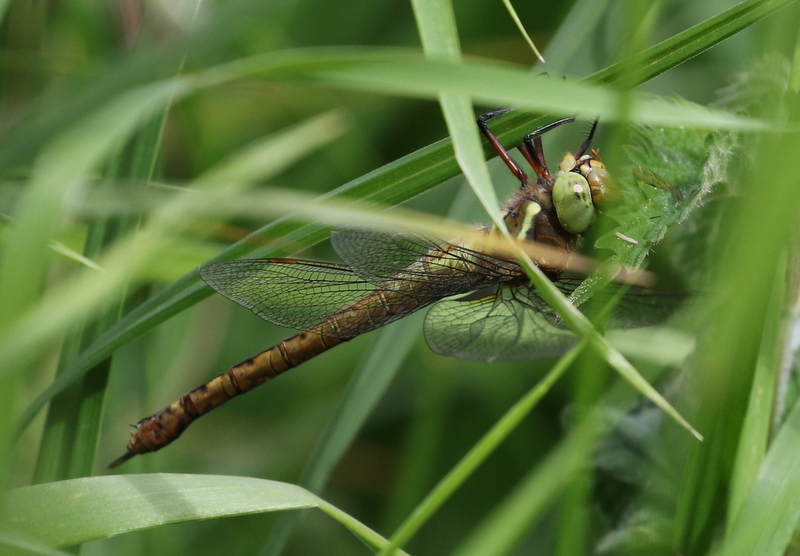 Norfolk Hawker – landed in the vegetation along the river bank
Norfolk Hawker – landed in the vegetation along the river bank
Back at the car, we had a quick a quick look amongst the cattle on the approach road to see if we could see the Cattle Egret which has been here on and off for a few days, but there was no sign of it. There are lots of cows on the marshes all round here, and it seems possible this bird wanders further afield during the day, as it appears to be seen here mostly early and later in the day.
With an hour or so to spare before lunch, we had a quick walk out from Potter Heigham church and along Weaver’s Way. We could hear a Yellowhammer singing from the hedge further along the road, as we turned off along the footpath. There were lots of dragonflies here, hunting in the shelter of the hedges or basking on the bare ground out of the wind. We saw our first Black-tailed Skimmers and Four-Spotted Chasers of the day.
Walking through the wood, we could hear Blackcap and Willow Warbler singing from the trees. Lots of Azure Damselflies were flying around the edge of the ditch on the far side. Another Norfolk Hawker was hawking up and down along the edge of the footpath along the bank. A Hairy Dragonfly perched up nicely for us, hanging on the leaf of a reed stem at the edge of the path, despite the wind.
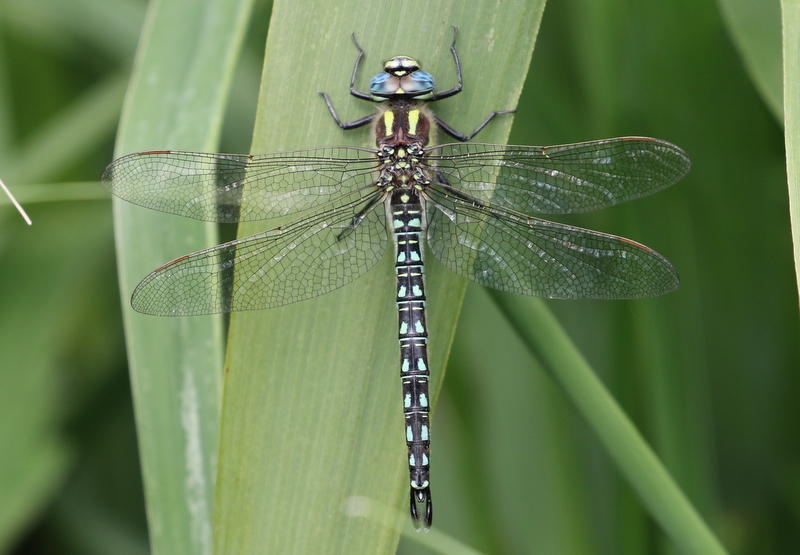 Hairy Dragonfly – the distinctive hairs on the thorax just visible
Hairy Dragonfly – the distinctive hairs on the thorax just visible
We had a quick look out over Hickling Broad, which revealed only a few Mute Swans in the distance and a single pair of Great Crested Grebe. Rush Hill Scrape looked similarly rather quiet today. A Marsh Harrier quartered over the reeds.
We had come here hoping to see our first Swallowtail butterfly of the day, as we figured this part of the reedbed might be more sheltered from the wind. There were very few butterflies at first along the path, until we found a couple of Small Tortoiseshells feeding on the brambles. We continued on past Rush Hill Scrape and finally found a Swallowtail. It flew in and landed on the brambles close to us, feeding on the flowers. It was keeping well down out of the wind, which hampered the photographic efforts, but we all got a great look at it.
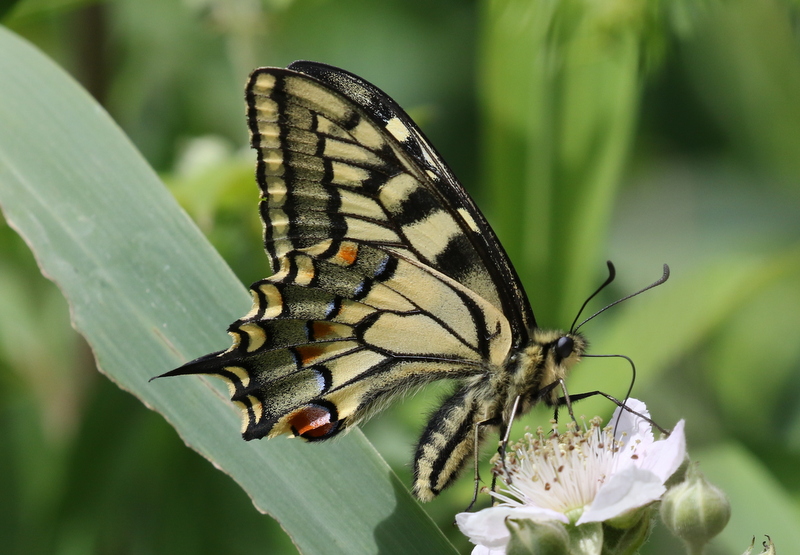 Swallowtail – our first of the day, feeding on bramble flowers
Swallowtail – our first of the day, feeding on bramble flowers
Swallowtails are restricted in the UK to the Norfolk Broads and with only a short flight season from May to early July, this is the only time and place to see them. A must see at this time of year! With that one in the bag, we headed back to the car and round to Hickling village for a pub lunch.
After lunch, we made our way over to Upton Fen. This is a particularly good site for dragonflies but we were also hoping to see some orchids. We quickly started to find lots of purple Southern Marsh Orchids and paler Common Spotted Orchids, with their distinctive leaf spots. But there are also some confusing hybrids here – these two species readily mix – so we didn’t stop and look too closely!
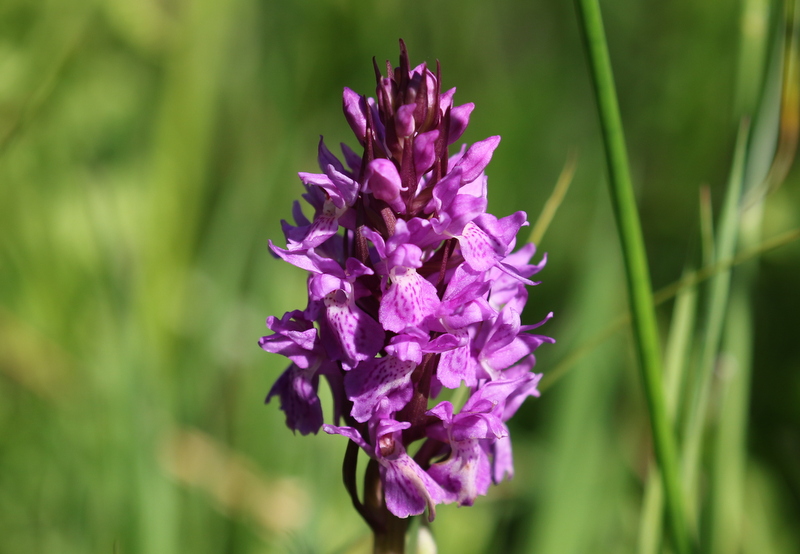 Southern Marsh Orchid – common around the Fen
Southern Marsh Orchid – common around the Fen
This site is known as one of the few places in the UK where you can see the very rare Fen Orchid. Most of the area where these flowers are found is now fenced off, but we eventually located a single Fen Orchid outside the fence. They are very small and not especially striking orchids at the best of times, but this was not a particularly good example either. The non-orchid enthusiasts in the group were perhaps a little underwhelmed and more impressed with the commoner orchids here!
 Fen Orchid – not the best example of this rare species
Fen Orchid – not the best example of this rare species
It was bright and sunny now, and warm, so there was not much bird activity. We heard the occasional Blackcap, Chiffchaff and Willow Warbler singing in the trees. We thought we could hear a Grasshopper Warbler reeling in the distance, but it was very hard to hear over the wind rustling the leaves on the trees. We made our way along a path towards it and eventually got to spot where we could hear its distinctive song. But the path ran out and it was presumably keeping low down out of the wind, so we couldn’t get near enough to even try to see it.
There were several Swifts hawking low over the open Fen, trying to find insects out of the wind. A Hobby made a quick pass up and down over the edge of the trees. When we got out of the trees and onto the marshes beyond, we could see a could of Marsh Harriers quartering. Then we turned to head back, with a Stock Dove on the wires the most notable bird on the way.
Much of the Fen was rather quiet today, as far as dragonflies were concerned, perhaps because of the wind. We did see a few more Norfolk Hawkers on our travels. However, the highlight was a single Brown Hawker on the walk back along a sheltered path between lines of trees, its golden brown wings glowing in the afternoon sun.
We finished off the day with a quick visit to How Hill on our way back. We were hoping to get better photos of Swallowtails here, but the highlight was probably a Hobby which was hawking over the trees and marshes by the river, passing right over our heads at one point.
 Hobby – great views of this one hunting at How Hill this afternoon
Hobby – great views of this one hunting at How Hill this afternoon
There were just a few butterflies on the brambles here at first, several Small Tortoiseshells and a single Large Skipper, which was a new one for the day. A pair of Banded Demoiselles perched in the nettles added to our damselfly list. We had almost got to the end of the path when we spotted two Swallowtails. It was rather windy here and they were very mobile, but eventually came and gave us great close views.
 Swallowtail – we saw two more at How Hill this afternoon
Swallowtail – we saw two more at How Hill this afternoon
It was a fitting way to end a day in the Broads with this iconic Broadland species, so we made our way back to the car.
















